LGBTQ+ representation through flags

The iconic, instantly recognizable rainbow flag featured on this year’s Sex Edition cover isn’t the only flag members of the LGBTQ+ community rally around. Since the late artist Gilbert Baker first flew the rainbow flag in 1978, countless other activists and artists have created identity flags. The font on the front cover is called “Gilbert,” named after Baker, who died March 31, 2017. Here, we go through a brief history of other LGBTQ+ identity flags that represent different parts of the broad community.
Rainbow pride flag
The traditional gay pride flag, the pattern most familiar, was created in 1978 by Gilbert Baker. With six original colors — red, orange, yellow, green, blue and purple — the flag was later expanded to include hot pink, turquoise and indigo. The official Gilbert Baker pride flag includes eight colors, each representing a different aspect of queer pride. In order, the colors symbolize sex, life, healing, sunlight, nature, magic, serenity and spirit.
Bisexual flag
The bisexual flag was designed by Michael Page in 1998. The top stripe of the flag is pink and the bottom stripe of the flag is blue, representing the stereotypical colors of men and women. The stripe in the middle is purple, representing an overlap of the two colors bordering it.
Transgender flag
The flag representing the transgender community was created in 1999 by Monica Helms, a trans woman. The flag consists of light pink and light blue — the pink representing baby girls and the blue representing baby boys. The stripe in the middle is white, representing those who are transitioning.
“The pattern is such that no matter which way you fly it, it will always be correct. This symbolizes us trying to find correctness in our own lives,” Helms said.
Lesbian flag
The lesbian flag consists of six shades of red and pink variations with a white stripe in the middle. The original flag included a red kiss symbol in the upper left hand corner, but in later versions, the kiss was removed.
Asexual flag
With its colors, the asexual flag represents several ace identities. The flag was created in 2010 by a member of the Asexual Visibility and Education Network, or AVEN, and includes four colors — black, gray, white and purple. The black signifies asexuality, gray signifies gray-sexuals and demisexuals, white signifies nonsexual partners and allies and purple signifies community.
Demisexual flag
The demisexual flag was created based on the colors of the asexual flag, but what distinguishes them is the way the colors are arranged. On the asexual flag, the colors black, gray, white and purple are arranged in horizontal stripes. But on the demisexual flag, the same colors are arranged differently. The horizontal stripes are white, purple and gray, with white and gray being thicker stripes as compared to the purple. In addition, a black triangle is aligned on the left side.
Genderqueer flag
With lavender, white and green, the genderqueer flag represents androgyny, agender identities and nonbinary people, respectively. This flag was created in 2011 by Marilyn Roxie and has since become a symbol to the movement of gender neutrality.
Nonbinary flag
The nonbinary flag was created in 2014 by 17-year-old Kye Rowan. Though similar to the genderqueer flag, this flag was created for nonbinary people who did not feel represented under the genderqueer flag. From top to bottom, the colors of the flag are yellow, white, purple and black.
Philadelphia People of Color Inclusive Flag
The Philadelphia people of color inclusive flag, created in 2018 by Daniel Quasar, is similar to the original pride flag, but with the addition of black and brown stripes at the top. This is an effort to emphasize that the LGBTQ+ community includes members of all skin colors.
Joanna Li is the layout editor at The Pitt News. From Indiana, PA, Li began at TPN in the fall of 2017 as a culture writer and previously served as assistant...






